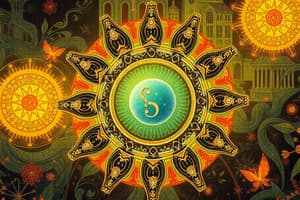Podcast
Questions and Answers
Calculate the atomic mass number of a carbon atom in terms of amu.
Calculate the atomic mass number of a carbon atom in terms of amu.
The atomic mass number of a carbon atom is calculated by adding the number of protons and neutrons, which is equal to 6 protons + 6 neutrons = $6 \times 1.672 \times 10^{-24} + 6 \times 1.674 \times 10^{-24} = 12.0939$ amu.
What are elements that have no isotopes called?
What are elements that have no isotopes called?
Elements that have no isotopes are called monotropic elements. For example, $^{15}P$ is a monotropic element.
Define isotopes and provide an example.
Define isotopes and provide an example.
Isotopes are nuclides of the same element that possess the same number of protons and electrons but differ in the number of neutrons. An example is carbon isotopes, such as $^{12}C$, $^{13}C$, and $^{14}C$.
Define relative atomic mass (Ar) and provide a calculation example.
Define relative atomic mass (Ar) and provide a calculation example.
What is the unit of atomic mass number and why is it convenient to use this unit?
What is the unit of atomic mass number and why is it convenient to use this unit?
Flashcards are hidden until you start studying



